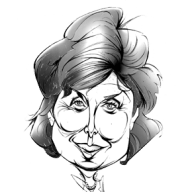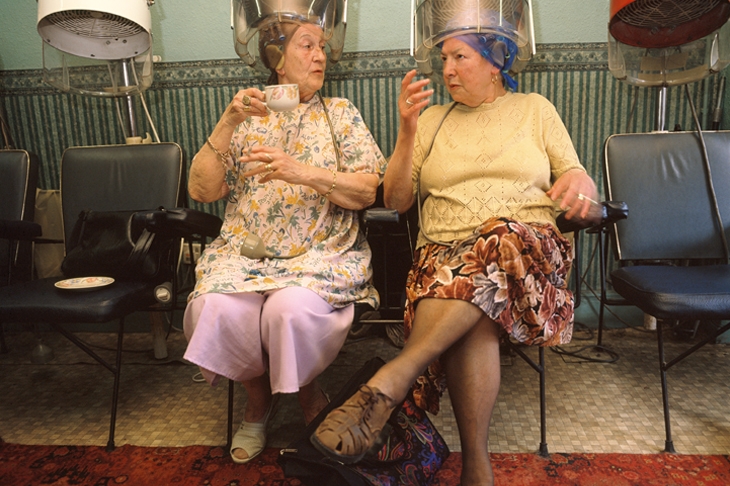One of the best things about Beehives, Bobs and Blow-dries — yep, an exhibition about hairdressing — is the reaction of visitors. Some are getting on a bit and their pangs of recognition as they pass 1970s straightening tongs or Carmen heated rollers are evident. One woman exclaimed, as she passed a Ronson hairdryer with its shower-cap hood, ‘Ooh, they were good, they were. We’ve only just got rid of my mum’s.’ A hairdresser called Keith from Wakefield observed of the Beatles era that it was a worrying time to begin with: ‘Nothing happened for about two or three months. Nobody came. We thought we’d lost our business. But it turned out that the men were just growing their hair. They came back when it was shoulder length.’
The thing about hair is that we’ve all got it — well, most of us — and how we handle it, cut it, style it, treat it, colour it, says lots about us, and about the age. Yet hairdressing as a marker of social change doesn’t often get its due. This little exhibition at the Civic, Barnsley, is an attempt to put that right. It’s a bid to summarise the art, science and politics of hair from the 1950s to our own time, from the beehive to transgender salons (yep, non-binary), in a small space.
Quite a lot of room is given over to the portfolio of Andrew Barton, the local Barnsley boy made good as British Hairdresser of the Year (2006). But it’s the artefacts of hairdressing that are so captivating: the hood dryers, the Wella machine with what look like dozens of scary electrodes, the jars and jars of Brylcreem; the hairnet proudly advertised as being made of human hair; the West Indian castor oil. All of these sum up their era. Visitors contemplate the hair products of their youth — the L’Oréal colour charts — as museum pieces. ‘It’s frightening,’ said one woman wistfully. This is an exhibition that rejoices in the ordinary things that were the stuff of hairdos.
There’s a succession of evocative advertisements and photos — and it is in the ads that we encounter the first celebrity hairdresser, the glorious Raymond ‘Teasy-Weasy’ Bessone (1911–92), who was a Saturday prime-time TV star and could command the price of a small house (£2,500) for being summoned to do Diana Dors’s hair in 1956. He was the granddaddy of the big-name hairdressers who turned themselves into brands. Then came Vidal Sassoon, his disciple, and his bobs and geometrical five-point cuts. My friend Neville (of Pont Street) used to say lugubriously that when he was beginning his own hairdressing career, he would try to use his cousin as a guinea pig for those cuts, but she, like me, had thick, wavy hair that stubbornly resisted anything geometric; they only worked on a certain sort of hair.
There’s Twiggy here, too, but alas, nothing about Leonard Lewis, probably the greatest hairdresser of the era, who not only invented Twiggy’s look, and trained umpteen celebrity hairdressers, but did everyone’s hair in the 1960s and ’70s, including John F. Kennedy and the Kray Brothers (once both at the same time).
But if it misses out Leonard, black hairdressers get their due. In the 1960s most British hairdressers couldn’t handle black hair, so people would cut each other’s hair at home, a hugely enjoyable ritual. Actually, black hair had a hard time of it until recently; from the time when ‘grease’ (originally animal-derived) was the product used to tame it to the advent of horrible harsh straightening products with industrial chemicals and the Jheri curl, which was a nightmare in the way of maintenance. Things changed with the advent of the Winifred Atwell Salon in Brixton in 1957 for West Indian clients, and black hair was thoroughly politicised with dreadlocks in the 1970s.
The exhibition takes us up to the transgender stuff, which doesn’t have a single trend, but it can’t escape the reality that hair is less fun these days; styling less directional. And with fewer skills: lots of stylists now can’t actually dress hair — they’d be stumped by the beehive, whose creator, Margaret Vinci Heldt, is celebrated.
The exhibition is weaker on men’s hair than on women’s, but then, as one visitor observed, for much of the period men really didn’t spend that much time in salons. Those evocative photos of women companionably sitting side-by-side under hood dryers — why, it was the female equivalent of men’s clubs. You spent more time in those days getting your perm or your colour and set. And, if you wanted, said Keith, the former hairdresser, you could share your secrets with your stylist (‘It were amazing what they’d tell you’). The pair of black hairdresser’s chairs here in faux-leather from the 1970s, with a cup of tea on the side: they sum up a social history, a vanished world.







Comments